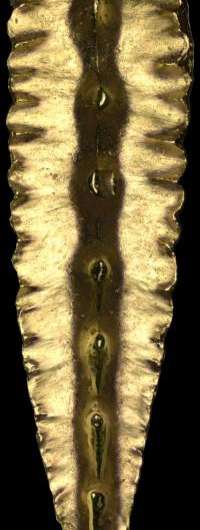Scientists find gold-plated fossil solution
(Phys.org) -- An international team of scientists in the University of Leicester’s Department of Geology has found a solution to a research problem involving fossils right next door - in the University’s Chemistry Department.
Many objects, including fossils, can reveal a huge amount of scientific information when studied using the high power magnification of electron microscopes, but in order to study tiny fossils or microscopic details of larger fossils in this way, palaeontologists routinely coat the fossils with an ultra-thin layer of gold. This obviously changes the way the fossil looks, and so it is often necessary to remove the gold after analysis, but this is difficult and expensive and uses dangerous chemicals like cyanide.

University of Leicester chemists are developing industrial electro-plating and polishing techniques using liquid salts called ‘ionic liquids’ which are safe, cheap and environmentally friendly. Scientists from the two departments got together to see whether a similar process could be used on fossils. The work was supported by the Natural Environment Research Council (NERC).
They found that ionic liquids can remove gold quickly and easily without damaging even tiny, delicate fossils. The liquids are safe to handle, can be simply disposed of and can even dissolve the gold without affecting the glue that holds the fossil specimen in place for analysis.
Professor Mark Purnell, from the Department of Geology, said: “There are many cases where collecting the evidence required for research affects fossils or other objects in ways that might be considered as somewhat destructive – gold coating for electron microscopy falls into this category. Understandably, this creates problems for places like museums which have to balance the value of research on their collections against the risk that specimens will be affected. This approach to gold removal offers a new way of tackling this problem that is safe for both researchers and the specimens.”
Professor Andy Abbott, from the Department of Chemistry, added: “This is a very nice demonstration of the use of ionic liquids for metal recovery but it is just the tip of the iceberg as we are using this technology for the recycling of a wide range of alloys and waste materials. The University of Leicester is building a strong reputation for the development of sustainable materials.”
Details of the new technique have just been published in the journal Palaeontologia electronica.
Journal information: Palaeontologia electronica
Provided by University of Leicester


















